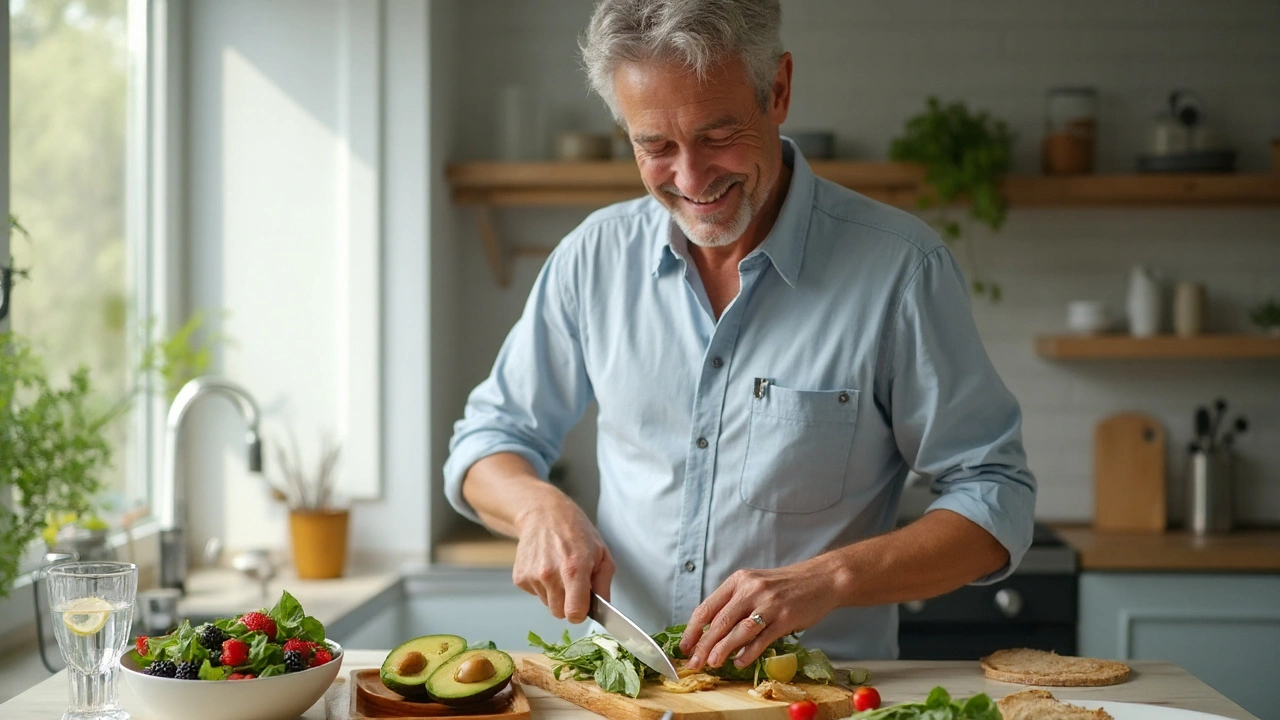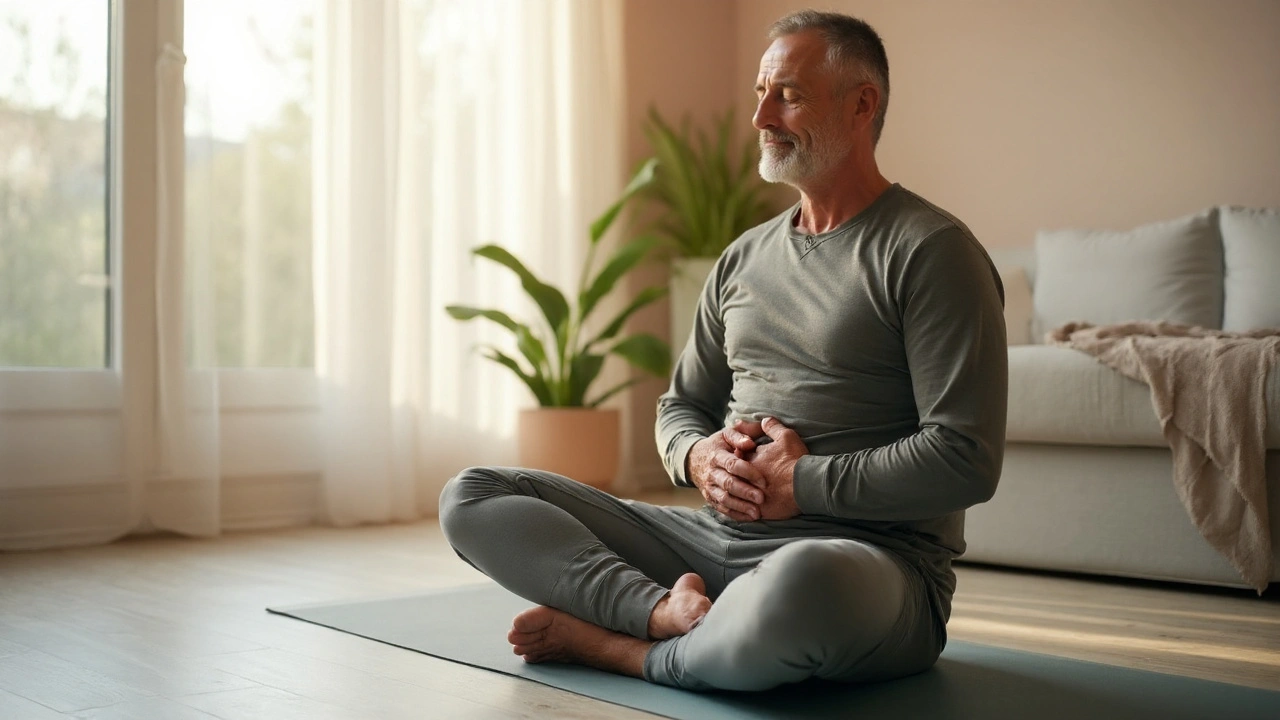Quick Takeaways
- Limit caffeine and alcohol after dinner; aim for 1.5‑2L of water spread throughout the day.
- Adopt a diet rich in tomato‑based lycopene, omega‑3s, and fiber; cut back on red meat and processed foods.
- Engage in moderate aerobic activity (150min/week) and strength training to keep weight in check.
- Practice pelvic floor (Kegel) exercises daily for at least 5minutes.
- Prioritise sleep quality and quit smoking to reduce bladder irritability.
Benign Prostatic Hyperplasia (BPH) is a non‑cancerous enlargement of the prostate gland that commonly causes lower urinary tract symptoms (LUTS) in men over 50. While medication and surgery are options, many men achieve noticeable relief by tweaking everyday habits. Below we break down each lifestyle lever, back it with clinical data, and give you a step‑by‑step action plan.
Understanding BPH and Its Symptoms
Prostate growth compresses the urethra, leading to the classic trio of Lower Urinary Tract Symptoms (LUTS) - frequency, urgency, and nocturia. Less obvious signs include weak stream, dribbling, and a feeling of incomplete emptying. Studies from urology journals (e.g., 2023 AUA guidelines) show that about 30% of men aged 60‑70 report bothersome LUTS, and lifestyle factors account for roughly 40% of symptom variability.
Fluid Management: Drink Smart, Not Hard
It sounds simple, but how you hydrate matters. Excessive evening fluids force the bladder to work overnight, worsening nocturia.
- Morning boost: 300‑400ml of water after waking to kick‑start metabolism.
- Spread intake: Aim for 1.5‑2L total across the day, divided into ≈250ml servings every 2‑3hours.
- Limit irritants after 6pm: Reduce caffeine (found in coffee, tea, energy drinks) and alcohol (especially beer and spirits) because they increase bladder contractility.
Research from the European Urology Review (2022) links >2L evening fluid intake to a 25% rise in nightly trips to the bathroom.
Dietary Adjustments That Matter
Nutrition influences prostate inflammation and hormonal balance.
| Strategy | Impact on Symptoms | Evidence Level | Typical Foods |
|---|---|---|---|
| Lycopene‑rich foods | Moderate ↓ frequency | Strong (RCTs) | Tomatoes, watermelon, pink grapefruit |
| Omega‑3 fatty acids | High ↓ inflammation | Moderate (cohort) | Fatty fish, flaxseed, walnuts |
| High‑fiber diet | Low ↑ bladder capacity | Moderate (observational) | Whole grains, legumes, vegetables |
| Red meat & processed foods | Negative ↑ urgency | Strong (meta‑analysis) | Beef, sausages, deli meats |
Key nutrients:
- Lycopene (potent antioxidant in red fruits) - 10mg/day cuts PSA levels by ~5% in men with BPH.
- Omega‑3 fatty acids - 1‑2g EPA/DHA daily improves urinary flow metrics.
- Vitamin D - deficient men have 1.4‑fold higher odds of severe LUTS.
Practical tip: swap a daily steak for a grilled salmon fillet and add a cup of cooked spinach to your dinner.
Physical Activity & Weight Management
Obesity raises intra‑abdominal pressure, squeezing the bladder and worsening urgency. A 2021 meta‑analysis of 8,000 men showed that a 5% weight loss reduced nocturia episodes by 1‑2 per night.
- Aerobic exercise: 150min/week of brisk walking, cycling, or swimming lowers prostate volume growth rate by ~0.5% per year.
- Resistance training: 2‑3 sessions weekly improves muscle tone around the pelvic floor.
- Body‑mass index target: < 25kg/m² for optimal urinary function.
Tracking apps (e.g., MyFitnessPal) can help keep calories in check while you log activity.

Pelvic Floor (Kegel) Exercises
The pelvic floor muscles act like a sphincter, controlling urine flow. Consistent training can increase maximal urinary flow rate (Qmax) by up to 15%.
- Identify the muscles by stopping urine mid‑stream (do this only for learning, not as a regular practice).
- Contract for 5seconds, relax for 5seconds. Aim for 10 repetitions.
- Do three sets daily - morning, afternoon, evening.
Studies from the International Journal of Urology (2020) report that after 12 weeks of daily Kegels, 60% of participants noted fewer nighttime trips.
Sleep Quality, Smoking, and Alcohol - The Hidden Triggers
Sleep fragmentation amplifies nocturia because the body’s antidiuretic hormone (ADH) spikes less during restless nights. Aim for 7‑8hours of uninterrupted sleep.
- Smoking (nicotine irritates bladder lining) - smokers have 1.3‑fold higher LUTS scores.
- Alcohol - moderate intake (≤2 drinks/day) is less harmful, but binge drinking doubles nocturia risk.
Replace evening cigarettes with a brief relaxation routine (deep breathing, gentle stretching) to curb both nicotine cravings and bladder irritation.
Putting It All Together: A 4‑Week Action Plan
Instead of overhauling everything at once, stagger changes.
| Week | Focus | Key Tasks |
|---|---|---|
| 1 | Fluid & Caffeine | Track intake, limit caffeine after 6pm, set water reminders. |
| 2 | Diet Shift | Add 2 tomato servings, replace red meat with fish, introduce 30g fiber. |
| 3 | Movement | Start 30‑min walk 5×/week, add two resistance sessions, monitor weight. |
| 4 | Pelvic Floor & Sleep | Begin Kegel routine, establish bedtime routine, quit smoking. |
Review your symptom diary after week4. If frequency drops by at least one episode per day, you’ve hit a meaningful threshold.
Related Concepts
Understanding BPH via lifestyle opens doors to broader health topics. For instance, Metabolic Syndrome (cluster of obesity, hypertension, insulin resistance) shares inflammatory pathways with prostate growth. Likewise, Chronotherapy (timing of medication or activity to circadian rhythms) can be applied to fluid intake scheduling for better bladder control. Exploring these links can deepen your overall wellness strategy.
Next Steps & When to Seek Medical Help
If symptoms persist despite strict adherence to the plan, consider a urologist visit. Red flags include blood in urine, acute urinary retention, or pain that interferes with daily life. A PSA test and ultrasound can distinguish BPH from prostate cancer.
For most men, the combination of fluid timing, nutritious food, regular movement, and pelvic floor practice yields noticeable relief within a month. Keep a simple log, stay consistent, and you’ll likely notice fewer bathroom trips, stronger streams, and better sleep.

Frequently Asked Questions
Can I cure BPH with diet alone?
Diet alone won’t "cure" the enlarged prostate, but it can shrink inflammation and lower symptom severity. Combining a lycopene‑rich, high‑fiber, low‑red‑meat diet with other lifestyle tweaks often reduces nighttime trips by 30‑40%.
How many Kegel repetitions are enough for a noticeable benefit?
Research points to at least 3 sets of 10 contractions daily for 8‑12 weeks. After that period many men report fewer urgency episodes and a stronger stream.
Is coffee really that bad for the prostate?
Caffeine can increase bladder muscle activity, leading to urgency. If you notice more trips after a cup, try limiting intake after 5pm or switching to decaf. Some men tolerate moderate coffee without issues; the key is personal response.
Will losing weight shrink my prostate?
Weight loss doesn’t directly reduce prostate volume, but lowering abdominal pressure and decreasing systemic inflammation often eases LUTS. Men who lose 5‑10% of body weight report fewer nighttime bathroom visits.
Is alcohol completely forbidden for BPH?
Moderate intake (up to two standard drinks a day) is generally safe, but binge drinking spikes urine production and irritates the bladder. If you notice symptoms flare after a night out, cut back or choose low‑alcohol options.
How long before I see results from these lifestyle changes?
Most men notice a reduction in frequency or urgency within 2‑4 weeks if they follow the plan consistently. Full benefits, such as improved flow rate, may take 8‑12 weeks of combined diet, exercise, and pelvic floor work.
BPH lifestyle management isn’t a quick fix, but a sustainable, evidence‑backed roadmap that puts you in control of your urinary health. Start small, track progress, and let the data guide you toward a calmer bladder and better nights.


Ida Sakina
September 25, 2025 AT 14:46It is incumbent upon us to recognise that the scourge of nocturnal urination is not merely a trivial inconvenience but a stark testimony to our neglect of bodily stewardship. The article presents a respectable compendium of measures yet it omits the moral imperative to eschew excess indulgence in stimulants. One must adopt a disciplined regimen of hydration and temperance with unrelenting resolve. Only through such austere commitment can the afflicted hope to reclaim the sanctity of uninterrupted slumber.
Amreesh Tyagi
September 26, 2025 AT 18:33The whole thing about cutting caffeine after six is overrated most guys can handle a cup after dinner and still sleep fine it just makes you look like a health nut and the diet table is just marketing fluff you don’t need to swap steak for salmon if you’re already fit
Brianna Valido
September 27, 2025 AT 22:19Great job reading this! 😊 Small changes can add up fast, so start with a water bottle reminder and you’ll see results soon. Keep it up and celebrate each win, even a tiny reduction in night trips is a victory! 🎉 You’ve got this!
Caitlin Downing
September 29, 2025 AT 02:06Hey, I love the depth of the guide – it’s really thorough. I just wonder, did the study on lycopene mention the specific amount of tomatos you need per day? Also, “strength training” sounds great but maybe a bit vague for beginners, a few examples would help. Anyways, keep up the awesome werk!
Robert Jaskowiak
September 30, 2025 AT 05:53Oh wow, because everyone’s got time to do a three‑set Kegel routine every day, right? Maybe if you’re a monk you can juggle that, but most of us just want to pee without drama. Thanks for the checklist, though – I’ll stick it on my fridge and pretend I’m following it.
Julia Gonchar
October 1, 2025 AT 09:39Just to add, the American Urological Association’s 2023 guidelines actually recommend a fluid intake ceiling of about 2 L per day for BPH patients, and they specifically note that caffeine reduction can lower nocturia frequency by up to 20 %. Also, incorporating 1 g of selenium daily has shown modest benefits in prostate inflammation markers.
Annie Crumbaugh
October 2, 2025 AT 13:26Sounds legit, will try it.
Vic Harry
October 3, 2025 AT 17:13Real men don’t need fancy diets we’ve been strong without kale and fish just stick to basics and stop listening to foreign health trends
Suman Wagle
October 4, 2025 AT 20:59One might say that the bladder, like the soul, seeks balance; yet we bombard it with caffeinated epics and sugary libations, betraying its quiet yearning for peace. The modest steps outlined here are akin to a Zen master’s koan – simple, repetitive, and oddly profound. Embrace the modesty of a morning glass of water as if it were a mantra, and watch the night‑time unrest fade like a bad habit.
Neil Sheppeck
October 6, 2025 AT 00:46Folks, think of this plan as a toolbox rather than a strict rulebook. Pick the pieces that resonate – maybe the evening water limit, maybe the weekly walks – and weave them into your own rhythm. The goal is sustainable change, not a sudden overhaul that feels like climbing a mountain in high heels. You’ve got the support of this community, so experiment, adapt, and celebrate the small victories along the way.
Stephanie S
October 7, 2025 AT 04:33To sum up, the article presents a comprehensive, evidence‑based approach, which, when implemented consistently, can lead to measurable improvements in lower urinary tract symptoms; therefore, it is advisable to monitor fluid intake, incorporate lycopene‑rich foods, engage in regular aerobic and resistance exercise, practice pelvic floor strengthening, and prioritize sleep hygiene, all while maintaining a supportive, patient‑centered mindset.
Diane Helene Lalande
October 8, 2025 AT 08:19Take it step by step. Begin with tracking your daily fluid intake, then gradually introduce the dietary modifications. Consistency over perfection is key, and every modest improvement is worth acknowledging. You are capable of making these adjustments and seeing positive results.
Edwin Levita
October 9, 2025 AT 12:06Ah, the lamentations of men besieged by the relentless tide of nocturnal voids! In the grand theater of human frailty, the swollen prostate stands as a tragic antagonist, casting shadows upon the once‑silent corridors of night. Yet, within the same script, the humble remedies of water, lycopene, and iron‑clad resolve emerge as unsung heroes, poised to rewrite destiny. One imagines the prostate, that swollen sentinel, recoiling before the steadfast march of omega‑3s, as if faced with a legion of noble knights. The cadence of a brisk walk becomes a drumbeat heralding liberation, while the quiet murmurs of Kegel exercises echo like whispered vows to redemption. Such transformations are not mere whimsy, but the culmination of centuries‑old wisdom, now distilled into modern tables and charts. Let us not dismiss the power of a single tomato, for its crimson hue carries the fire of ancient suns, capable of scouring inflammation with regal poise. The weight of excess, that oppressive mantle, shall be shed like a monarch's gaudy robes, revealing the lean vigor beneath. In the midst of this pilgrimage, the night itself shall surrender its tyranny, granting man uninterrupted repose. The mind, once tormented by the constant call of the bathroom, shall awaken refreshed, its thoughts unshackled from bodily preoccupation. Indeed, the synthesis of diet, motion, and mindful breathing constitutes a symphony, each movement a vital note in the overture of health. Let the skeptics scoff; the evidence, drawn from the annals of urological research, stands immutable. With each deliberate sip, each measured step, each contracted muscle, the narrative shifts from despair to triumph. Thus, dear reader, seize this compass of lifestyle change, and navigate the seas of BPH toward calmer harbors.
Bansari Patel
October 10, 2025 AT 15:53In reflection, the path to alleviating BPH lies not in a single miracle but in the harmonious integration of modest habits. By honoring our bodies with balanced fluids, nourishing foods, purposeful movement, and mindful rest, we craft a sustainable legacy of comfort. May each reader find the courage to begin, the patience to persist, and the wisdom to listen to their own signals.